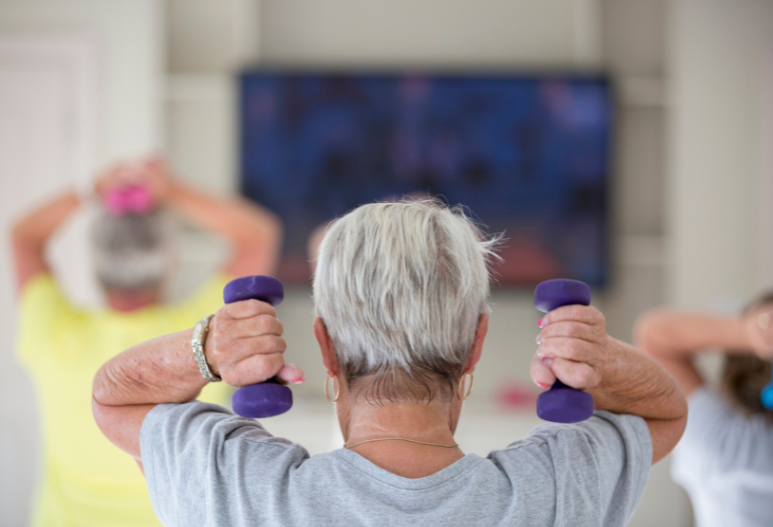Exercise can prevent an estimated 100,000 deaths of older adults each year. People 65+ who get at least 150 minutes of moderate exercise each week can help delay or prevent age-related injury/illness. The best exercise routines are those that incorporate aerobic (cardio) exercise, muscle/strength building, and balance practice. Today, we’ll learn about the best exercise for seniors that can improve one or more of these functions.
Note: Before beginning any exercise plan, it’s wise to get medical clearance. This is particularly true for those of us who haven’t exercised in a while. This helps us avoid injury and seek advice about how to exercise safely with existing health conditions.
1. Walking
In most cases, walking is a low-risk activity because it’s a natural movement with no learning curve.
Walking:
- is low cost; all we need is a good pair of shoes and a place to walk
- supports knee health by helping them stay lubricated, reducing pain
- improves balance, lessening the risk of falling
- provides interaction with the world and other people, lessening loneliness
- reduces blood sugar
- reduces stress
- boosts the immune system
- reduces blood pressure
2. Yoga
Yoga is a group of practices that focus on physical exercises, mindfulness, and spiritual practices. It originated in ancient India 5000 years ago.
There are many types of yoga, each with its own philosophy. Common areas of focus include poses (asanas), meditation, diet, breathing, chanting, and relaxation.
In the West, we commonly focus on the physical practice of yoga. This requires us to practice different poses, ranging from simple to very challenging. Mindful breathing is also a common element of Western yoga.
Yoga:
- improves strength and flexibility
- reduces arthritis symptoms
- improves sleep quality
- reduces stress
- boosts energy
- relief of chronic back pain
3. Swimming
Swimming is the fourth most popular exercise activity in the U.S. It’s a great cardio exercise that’s gentle on the body.
Swimming:
- improves heart and lung health
- boosts endurance
- strengthens bones
- increases flexibility in the hips, legs, neck, and back
- improves posture
- reduces back pain
- can be a social activity to reduce loneliness and depression
4. Strength Training
Strength training (aka resistance training) helps us build strong muscles by working against an outside force.
When we think about strength training, we likely picture weightlifting. And while certainly most popular, there are other strength training methods we can use, like:
- resistance bands
- bodyweight
- medicine balls and sandbags
- suspension-style equipment
Strength training:
- increases muscle mass
- increases flexibility
- reduces blood pressure
- helps manage pain, such as back pain
- improves balance
- helps improve bone density and reduce the risk of osteoporosis
- helps prevent and control diseases like type 2 diabetes, obesity, heart disease
- boosts mental health
- improves sleep
All activities mentioned also help us maintain a healthy weight. This is important for our overall health, from joint wellness to heart health.
Summary
As we age, we become more susceptible to injury and illness. Regular exercise helps combat this and increases our chances of remaining independent and thriving.
Exercise helps us strengthen our bodies and minds, and engage with the world around us.
There’s no age limit on feeling good, so get active and live well!
Sources:
https://www.physio-pedia.com/Strength_Training
https://www.betterhealth.vic.gov.au/health/healthyliving/Walking-the-benefits-for-older-people
https://www.medicalnewstoday.com/articles/286745#types
https://www.hopkinsmedicine.org/health/wellness-and-prevention/9-benefits-of-yoga
https://www.seniorhelpers.ca/blog/benefits-of-swimming-for-seniors-0

